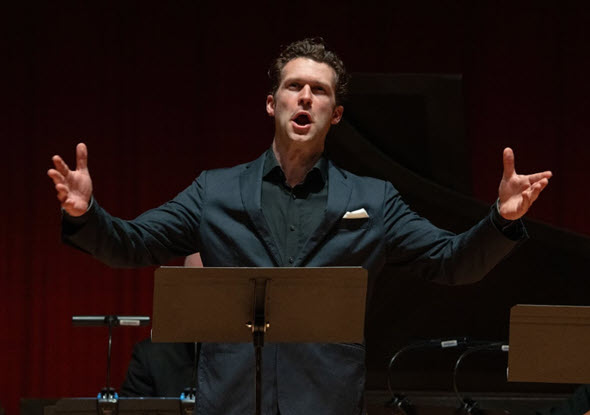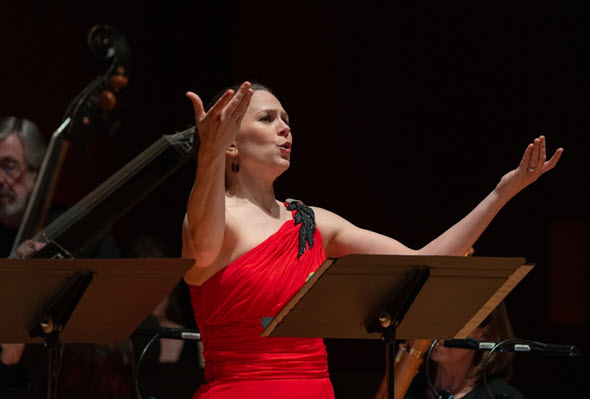Baroque bounty: Haymarket revives oratorio, Bella Voce turns spotlight on its band Sinfonia

Bass-baritone Christian Pursell sang the role of Herod in a long-obscured 1715 version of the tale of Salome and John the Baptist. (Elliot Mandel photo)
Commentary: As Haymarket Opera fills in a 300-year gap, choral group Bella Voce presents its instrumental ensemble in debut.
By Lawrence B. Johnson
If you know where to look, and you don’t have to look far, you’ll find Baroque music so well served in Chicago that our musical locus can sometimes feel like Venice, Leipzig or London in the early 1700s. On recent consecutive nights, the ever-enchanting Haymarket Opera offered what was apparently the first performance in 300 years of Maria Margherita Grimani’s 1715 melodrama “The Beheading of John the Baptist” (or “La decollazione di San Giovanni Battista”), and the splendid vocal ensemble Bella Voce showcased its instrumental component Sinfonia in its first stand-alone concert. The adjacent events, March 22-23, conjured an aura of subtle riches.
I can’t put Haymarket’s contribution to Chicago’s musical culture more succinctly than the company does on its website: “Since its founding in 2010, Haymarket has offered more than 30 productions using period instruments and historically informed staging conventions, shining a spotlight on many lesser known but quality pieces by a wide diversity of composers, sung and played by a combination of international stars and top regional talent.”
Lesser known, indeed. Haymarket’s latest production, in a single performance in Gannon Concert Hall at DePaul University, was Grimani’s oratorio on the martyrdom of John the Baptist at the pleasure of Herod’s step-daughter Salome. Musically, it’s quite elegantly and expressively written; conceptually, it’s a fascinating take on a story that we tend to think of as lurid and sexually fraught, thanks to the modern theatrical examples of Richard Strauss and Oscar Wilde. But Grimani’s oratorio — perhaps more cantata, as it lacks a chorus — eschews the salacious in favor of pious moralizing.
This Salome is just a good daughter whose accomplished dancing — she doesn’t shed a single veil — is so greatly admired by her stepdad that he offers her whatever she would have, even half his kingdom. Ah, but the girl shuns wealth: She wants only retribution for all the rude things John has been spouting about her mother Herodias’ marriage to her ex-husband’s brother; she will have the prospective saint’s head. Which is fine with John, who sings how his impending death will only speed his journey to God’s bosom.

Never mind the flame-red dress, soprano Erica Schuller was not singing Salome but Herodias. (Elliot Mandel photo)
So deftly and engagingly composed is “La decollazione” that it might plausibly be the work of Handel, who spent time in Italy as a young man, in the first decade of the 1700s, before taking the trappings of Italian opera with him to London. In all but technical nomenclature, ‘La decollazione” is opera — anyway a formative opera. It has a dramatic arc, and its characters respond to each other even to the point of singing together. In any event, it’s quite a rewarding entertainment, and Haymarket’s revival was typically high-styled all around.
Vocally, the production was solidly anchored by bass-baritone Christian Pursell’s resonant turn as Herod and contralto Fleur Barron’s commanding performance as John the Baptist. Barron’s immersion in John’s piety, together with her masterful singing, soon had one waiting for the next moment when she would step from behind the band and again unleash that dark, compelling sound.
Rounding out the cast were soprano Kristin Knutson Berka’s rather demure Salome (she did not dance), tenor Eric Ferring’s agile and brilliant Confidant to Herod and soprano Erica Schuller’s vocally generous Herodias, whose red gown created some problematic optics vis-a-vis Salome in our modern notion of the psychotic lass in all her flamboyant perversity. The superb Haymarket orchestra, led from within by cellist Craig Trompeter, kept this operatic oratorio on a fine edge.

Music director Andrew Lewis, second from left, led Bella Voce’s Sinfonia in its inaugural concert. (Magda Krance photo)
The next night lured Baroque buffs through the seventh-floor catacombs of Roosevelt University to the acoustical intimacy of Ganz Hall, where Bella Voce presented the independent debut of its support band Bella Voce Sinfonia led by the organization’s artistic director, Andrew Lewis.
This was at once an absolutely core offering of classic Baroque instrumental fare and a rollicking good time. Like Haymarket’s pit band, the Bella Voce Sinfonia is made up of a comparative handful of highly accomplished musicians playing on period-style instruments under expert leadership. On this debut occasion, it was all strings with the exception of a Telemann concerto for violin, cello and trumpet.
For openers, Lewis programmed concerti grossi from two indispensable sets: Handel’s Op. 6, No. 1 in G major and Corelli’s Op. 6, No. 5 in B-flat major. Both works displayed the agility, fluency and sparkling synchrony of an ensemble that plays like a well-conditioned string quartet. The two concertos shared a buoyant spirit as well as rich sonorities and a supple pulse that seemed to spring not just from Lewis’ guiding hand but from deep inside the musical fabric. Shifting to the English Baroque, Lewis led an animated, luminous turn through Purcell’s nine-movement suite from his music for the playwright Aphra Behms’ “Abdelazer, or The Moor’s Revenge.”

Sans conductor, violinist Martin Davids (left), cellist Anna Steinhoff (seated) and trumpeter Ryan Berndt played a triple concerto by Telemann. (Magda Krance photo)
For two concertos, Lewis retired from the stage, leaving the band to its own devices. Both worked quite well with this small contingent of players. Telemann’s Concerto in D major for Violin, Cello and Trumpet brought together violinist Martin Davids and cellist Anna Steinhoff with Ryan Berndt playing a long Baroque trumpet much like an instrument of heraldry. The soloists made a bright, propulsive threesome with Berndt’s vibrant trumpet setting a distinctive stamp on this exception to the concert’s all-strings fare.
Also played sans conductor was Bach’s Concerto for Two Violins in D minor, in which Davids was joined by violinist Edwin Huizinga. Virtuosity fairly crackled as the two fiddlers whipped through the outer movements but took time in the central Largo to indulge the music’s spiritual warmth. Huizinga, bobbing and prancing and to-ing and fro-ing about the stage, indeed brought to mind an Irish fiddler at a hooley. Everyone was having fun. The Bella Voce Sinfonia had been cut loose.


